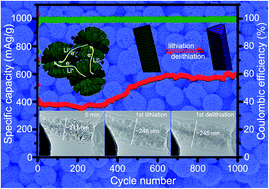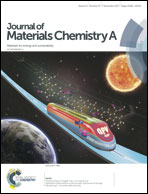A new strategy to effectively alleviate volume expansion and enhance the conductivity of hierarchical MnO@C nanocomposites for lithium ion batteries†
Abstract
Herein, a simple and an environmentally friendly approach is developed to fabricate the novel MnO@C hierarchical structure, derived from Mn-based metal organic frameworks, which is explored as an anode material for lithium ion batteries. Remarkably, the MnO@C microsphere electrode delivers an outstanding, long cycling capacity of 596.3 mA h g−1 at 5C (1C = 765 mA g−1) after 1000 cycles, and an excellent rate performance of 380.1 mA h g−1 at 10C. The overall outstanding properties of the hierarchical MnO@C composite can be attributed to the success of a new strategy for dual structure design, which provides two pathways for effectively alleviating volume changes and enhancing conductivity based on in situ TEM electrochemical experiments and electrochemical impedance spectra. Both the poor conductivity and great volume changes of the MnO electrode material can be effectively improved in two ways: the porous carbon matrix confining the MnO nanoparticles, and the hierarchical nanorod-assembled architecture. The structures herein suggest new design concepts for metal oxide nanoarchitectures for high performance electrode materials in lithium ion batteries.



 Please wait while we load your content...
Please wait while we load your content...